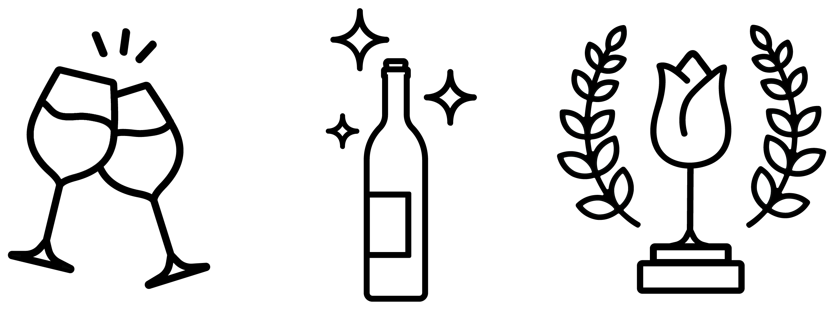Beyond the absence of conflicts of interest (we do not sell ads, medals, or trade show spaces to winemakers), we place great importance on tasting notes, which, as long as they are clear and well-written, seem to us more relevant than a numerical score that ultimately makes two fundamentally different wines appear identical.
That being said, a score is to wine what a passport is to a tourist: an essential document to cross borders and travel the world. It is also a quick means of comparison and a remarkably effective commercial tool.
La Tulipe Rouge was created to serve wine—that is, those who make it and those who buy it. Without abandoning what makes us unique in the world of wine media, we decided to introduce a 100-point rating system—our way. Explanation.

The scientific illusion
Let’s start with a question: what happens when two wines don’t play in the same league? According to this scale, an excellent Côtes-du-Rhône remains a Côtes-du-Rhône compared to a Grand Cru from Burgundy: these two wines are mistakenly judged on the same value scale—the 100-point system (or 20-point system, depending on preference)—even though their consumption objectives are completely different, if not outright opposed.
It is true that a score has a synthetic quality that is quite useful for those who lack the time or willingness to delve deeper. We agree, and that’s a problem. Under the guise of apparent precision (sometimes down to decimal points), the score flattens all the nuances that might exist between two wines. Variations between bottles, the order of tasting, the taster’s condition, and countless other situational factors further demonstrate that this apparent rigor is merely for show and subjects the winemaker to a fragile judgment that remains fixed forever. Some critics, concerned with fairness, taste the same wine multiple times, but averaging approximate results does not yield an accurate one.
As for the universal criterion that would allow anyone on the planet to know the "level" (note the quotation marks) of a wine, nothing could be more inaccurate! Yet this is what consumers accept when they search for wines by their score, regardless of the media consulted. When they are interested in a Californian Cabernet and a Beaujolais, both rated 90/100 by different publications, consumers may forget that the criteria leading to these scores can vary significantly depending on the critic. Put simply: not all 90/100 scores are created equal... just as not all critics are either. But that’s for you and the winemaker to judge. Not easy when you’re not part of the journalistic inner circle.
Quest and reality
Tasting is pluralistic; it relies—whether we like it or not—on subjective criteria and differing sensitivities that cannot be condensed into a universal metric system, whether it’s out of 20 or 100. So how do we proceed? You can’t please everyone. You have to choose your side. For Charles Baudelaire in his Salon de 1846, criticism must, "to be fair," be "partial, passionate, political—in other words, from an exclusive point of view, but one that opens up the most horizons." La Tulipe Rouge has chosen to champion successful wines because they seem to us to transcend generations of wine lovers. As for objectivity in judgment, we concede it a group subjectivity: no stars or gurus here, but a team of tasters working together—trained, competent, and united by the same passion for wine.
This is our quest, so to speak, for an ideal critique that must unfortunately contend with the demands of the outside world—the one where bottles are sold and consumed; where norms like the 100-point scale have taken precedence to streamline commerce. We regret this selfishly but must acknowledge this principle of reality embraced by buyers and... producers.
The 100-point wine-scoring scale by La Tulipe Rouge
The 100-Point Scale According to La Tulipe Rouge:
85-87 (12.5-13.5): A good wine representative of its region's generic style.
88-89 (14-14.5): A good, consistent wine representative of its region.
90-91 (15-15.5): A wine above the regional average.
92-93 (16-16.5): A substantial wine with distinctive origin and/or style.
94-95 (17-17.5): A substantial wine with gracefully expressed origin and/or style.
96-97 (18-18.5): A profound and refined wine defined by its style and origin.
98-99 (19-19.5): An evident perfection in style and construction.
100 (20): Not necessarily the greatest wine we’ve encountered but uniquely great!
By adopting this rating system, La Tulipe Rouge does not blindly accept its flaws or weaknesses. That’s why every 100-point score is paired with:
A detailed comment to personalize the score:
We are one of the few guides to provide detailed comments on ALL selected wines (non-selected wines receive comments exclusively for producers). This allows readers to form a precise idea of each selected cuvée.
A pictogram to contextualize the score:
We’ve created three pictograms to clarify the style of wines selected through blind tastings:
“Tchin”: For sharing wines that are easy for everyone to enjoy.
“Encore”: For more original and/or substantial wines.
“Tulipe”: For singular wines with exceptional characteristics.

By relying on one of these pictograms, the 100-point score takes on a relative value that highlights wines within their category. The glass ceiling (an insurmountable score limit) that automatically applies to certain appellations or regions disappears! Winemakers see their wines recognized for what they are, rather than for what they are not! Finally, buyers can choose a wine based on their consumption criteria, which an appellation, name, or grape variety all too rarely guarantees.
With this three-tiered approach—the 100-point score, the pictogram, and the commentary—it becomes easy to find what suits you best, whether you’re a casual consumer, seasoned enthusiast, producer, or professional buyer. This is the 100-point rating system according to La Tulipe Rouge: still imperfect, but undoubtedly fairer.
La Tulipe Rouge
